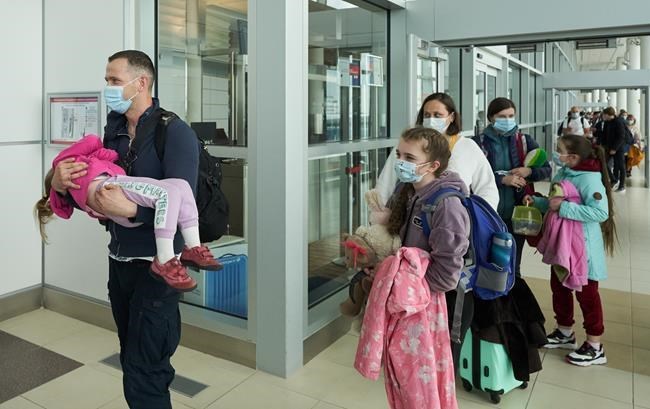OTTAWA — Ukrainians who have fled to Canada with an emergency visa find themselves in a "grey area" of the immigration system, and several settlement specialists are urging the government to make changes if the program is renewed.
Canada took a new approach to the crisis sparked by the Russian invasion last year, offering an unlimited number of temporary visas to Ukrainians to allow them to live, work and study in Canada while they figure out their next steps.
The idea was to offer refuge to people as quickly as possible, as millions of women, children and older adults fled the violence, without compromising the integrity of the immigration system.
But people who arrived in Canada under the emergency visa don't qualify for the same supports as people who arrive with a refugee designation, even though most of them think of themselves as refugees, said Ihor Michalchyshyn, executive director of the Ukrainian Canadian Congress.
They also don't qualify for certain government assistance, benefits and student loans, as permanent residents would.
"The usual programs and funding aren't available to these Ukrainians, and it's not organized," Michalchyshyn said in an interview Monday.
Nova Scotia immigration program director Simone Le Gendre described the confusion the province faced at the outset of the program because its usual immigration settlement guidelines did not apply to Ukrainians with emergency visas.
"What we had was a grey area — a group of people who had experienced trauma were coming to our province and needed to be connected to support very quickly," said Le Gendre, who spoke at the Metropolis Canada conference in Ottawa Friday.
The new arrivals had "refugee-like" needs, she explained, which prompted the province to set up special committees aimed at connecting people with housing, health care and income support top-ups.
Their task was made even more difficult by the fact that there was no central registry with arrival information, as there would be for permanent residents or refugees.
Provinces and agencies had no idea when Ukrainians would arrive, said Katie Crocker, the CEO of the Affiliation of Multicultural Societies and Service Agencies in British Columbia.
Instead, agencies like hers, the YMCA, the Ukrainian Canadian Congress and others stood up booths at airports to try to flag down Ukrainian newcomers as they arrived in Canada and let them know what kind of help was available.
The temporary visa program is set to stop taking new applicants on March 31, giving the government two weeks to decide whether to extend it.
So far, 603,681 people have been approved for a visa under the program as of March 9, 2023, though only 184,908 have actually come to Canada.
When asked about the next iteration of the program last week, Prime Minister Justin Trudeau said only that Canada would "continue to be there to support Ukrainian refugees in various ways, as necessary."
Crocker said if the program continues, the government should consider a few key changes.
"If we're not going to have them come as government-assisted refugees with a very clear pathway, then we do need to have some more concrete pre-arrival information (from) them about where they're going, when they're coming, who's coming with them, what their English language levels are, what their credentials are," said Crocker, who also spoke at the conference.
Those key details would allow settlement agencies to prepare for their arrival and connect them with jobs, housing and other resources they might need, she said.
She also suggested the government consider putting a cap on the number of applications it will approve.
The program was specifically designed without a cap as a way to bring people to Canada quickly, Immigration Minister Sean Fraser said last week at a press conference.
"We made the decision at the time to try something new, to offer temporary protection by leveraging the strength ... of Canada's tourism program, where we're not required to set a capped number of people that we can support, but we can process whatever applications come in," he said.
The immigration department says approximately 373 staff have been specifically dedicated to processing applications from Ukrainians, in addition to existing staff who work on the files as part of their regular duties.
Whatever "hiccups" associated with the emergency visas that may have affected immigration processing times are "well worth the value," said Fraser, who spoke last week at a press conference in Bridgewater, N.S.
The assumption at the time was that Ukrainians would likely return to their home country when the war ended. But increasingly, Ukrainians who come to Canada are showing an interest in staying, said Sarosh Rizvi, the executive director of the Alberta Association of Immigrant Serving Agencies.
A post-arrival survey of Ukrainians who arrived under the program shows that 84 per cent would like to become permanent residents once their emergency visas expire, he said.
"What does that mean for our infrastructure sector?" he said. "What does that mean for immigration levels?"
It also leaves an open question about what kind of support will be available to people who decide to stay if they are denied permanent status in Canada, he said.
Andrew Griffith, Canada's former director-general of citizenship and multiculturalism, said the government should consider creating targets for the number of temporary residents in the country each year, as it does for other kinds of immigration.
"There are those people that come on a temporary basis but then they transition to permanent resident, and because they're here, they also need housing, and public services and everything like that," Griffith said in an interview.
Michalchyshyn, who the government has consulted on the next phase of the emergency visa, said he is hopeful the government will announce more details of its plan this week.
This report by The Canadian Press was first published March 20, 2023.
Laura Osman and Dylan Robertson, The Canadian Press



